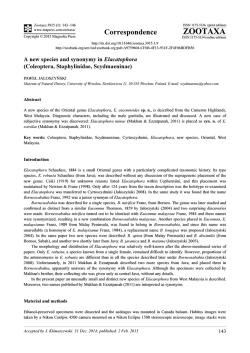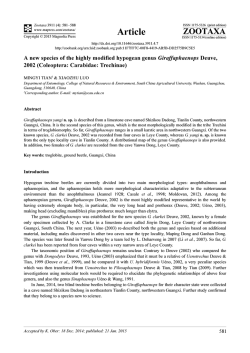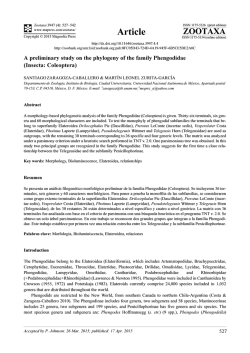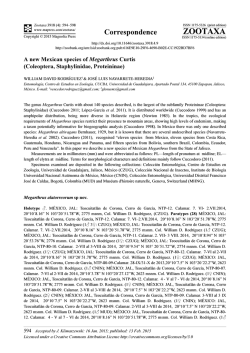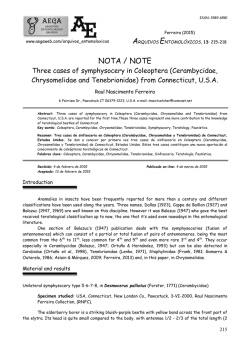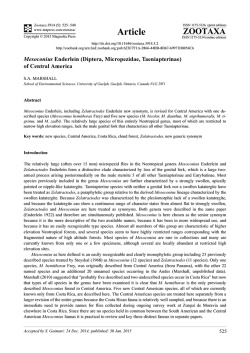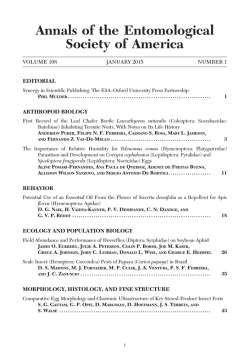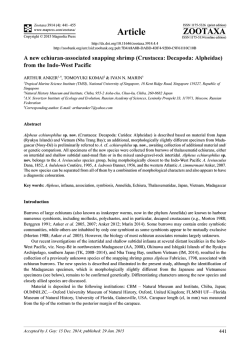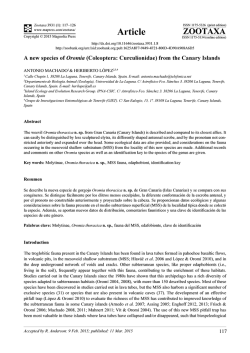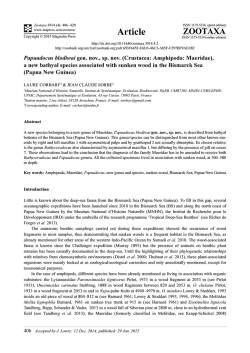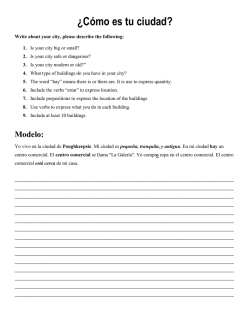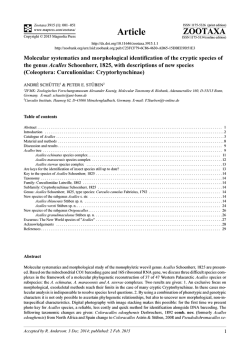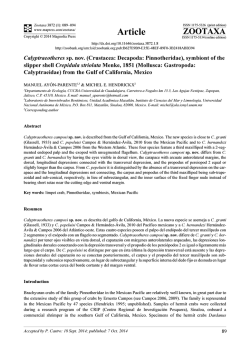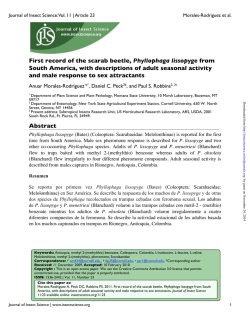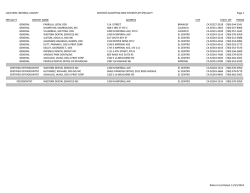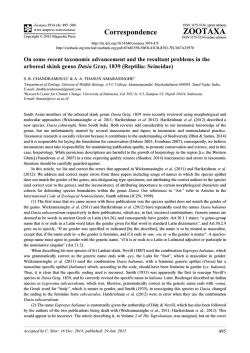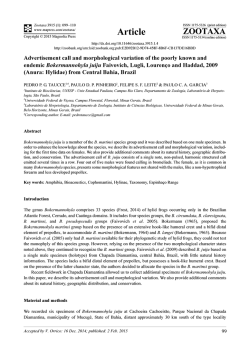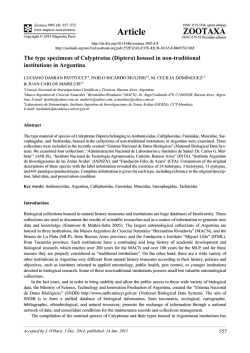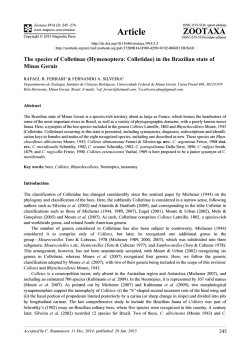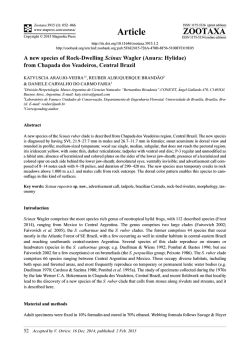
Coleoptera: Staphylinidae, Oxyporinae
Zootaxa 3914 (1): 071–076 www.mapress.com /zootaxa / Copyright © 2015 Magnolia Press Article ISSN 1175-5326 (print edition) ZOOTAXA ISSN 1175-5334 (online edition) http://dx.doi.org/10.11646/zootaxa.3914.1.5 http://zoobank.org/urn:lsid:zoobank.org:pub:713AE979-CCE4-408D-B66A-5B6A70C1F745 Description of the male of Oxyporus bautistae Márquez & Asiain (Coleoptera: Staphylinidae, Oxyporinae) JOSÉ LUIS NAVARRETE-HEREDIA1 & JUAN MÁRQUEZ2 1 Entomología, Centro de Estudios en Zoología, CUCBA, Universidad de Guadalajara, Apdo. Postal 134, 45100, Zapopan, Jalisco. E-mail: [email protected] 2 Laboratorio de Sistemática Animal, Centro de Investigaciones Biológicas, UAEH, Km 4.5, carretera Pachuca-Tulancingo s/n. Ciudad Universitaria, Col. Carboneras, CP 42184, Mineral de la Reforma, Hidalgo, México. E-mail: [email protected] Abstract The male of Oxyporus bautistae Márquez and Asiain, 2006 is described based on one specimen from San José del Pacífico, southern Oaxaca, Mexico. Oxyporus bautistae shares with O. mexicanus Fauvel, 1865 the bicolored color pattern in legs (black and orange). The male of O. bautistae has six black spots on tergites and the female has only two black spots; but we cannot explain whether the number of black spots represents a sexual character or individual variation. Key words: Staphylinidae, Oxyporus, Mexico, taxonomy Resumen Se describe el macho de Oxyporus bautistae Márquez y Asiain, 2006 con base en el estudio de un espécimen procedente de San José del Pacífico, sur de Oaxaca, México. Oxyporus bautistae y O. mexicanus Fauvel, 1865 son las únicas dos especies mexicanas que comparten el patrón de coloración en las patas (negro y anaranjado). El macho de O. bautistae muestra seis manchas negras en los terguitos, y la hembra solo tiene dos manchas negras, pero desconocemos si la variación en el número de manchas abdominales es un carácter sexual o variación individual. Palabras clave: Staphylinidae, Oxyporus, México, taxonomía Introduction The subfamily Oxyporinae (Coleoptera: Staphylinidae) is recognized as a monophyletic taxon whose members share at least the following evident apomorphies: mentum with long anterior projections, enlarged and crescentshaped apical labial palpomeres and mesocoxae widely separated by a large metaventrite (Thayer 2005). All extant members are grouped in a single genus, Oxyporus plus two extinct genera from the Early Cretaceous of China: Protoxyporus and Cretoxyporus (Cai & Huang 2014). Species richness is about 100 species divided in two subgenera: Oxyporus and Pseudoxyporus (Campbell 1969). Larvae and adults exhibit an obligate association with mature mushrooms, primarily Agaricales, Boletales and Polyporales; they feed on the spore-producing layer (Hanley & Goodrich 1995). Species of this genus are more diverse in the Holarctic and Oriental biogeographical regions but few species are recorded from the Neotropics with one interesting and extreme record from South America: Oxyporus bolivianus Scheerpeltz, 1960: 79. In Mexico Oxyporus is represented by eight species, two of them described in the last ten years: Oxyporus delgadoi Márquez, Asiain & Fierros-López, 2005 from Hidalgo, Zacualtipán, road to Santo Domingo and O. bautistae Márquez & Asiain, 2006 from Oaxaca, Santiago Yosondua, road to El Vergel, La Cascada (Fig. 1). Oxyporus bautistae was described based on three female specimens. No males were collected after several attempts sampling mushrooms and flight intercept traps at the type locality (Márquez & Asiain 2006). As part of the curatorial work at the Entomological Collection in the Centro de Estudios en Zoología, one male specimen Accepted by J. Klimaszewski: 10 Dec. 2014; published: 23 Jan. 2015 Licensed under a Creative Commons Attribution License http://creativecommons.org/licenses/by/3.0 71 Acknowledgments We thank J. Asiain (Centro de Investigaciones Biológicas, UAEH) for critical review of the paper and editing of the figures. Also, we thank M. A. Morón (Instituto de Ecología, A.C.) for review and suggestions made to the manuscript. References Cai, C.-Y. & Huang, D.-Y. (2014) Diverse Oxyporinae rove beetles from the Early Cretaceous of China (Coleoptera: Staphylinidae). Systematic Entomology, 39 (3), 500–505. http://dx.doi.org/10.1111/syen.12069 Campbell, J.M. (1969) A revision of the New World Oxyporinae (Coleoptera: Staphylinidae). Canadian Entomologist, 101, 225–268. http://dx.doi.org/10.4039/ent101225-3 Fauvel, A. (1865) Études sur les Staphylinides de l'Amérique centrale principalement du Mexique. Notices Entomologiques, 3, 1–18. Hanley, R.S. & Goodrich, M.A. (1995) Review of mycophagy, host relationships and behavior in the New World Oxyporinae (Coleoptera: Staphylinidae). The Coleopterists Bulletin, 49 (3), 267–280. Márquez, J. & Asiain, J. (2006) A new Mexican species of Oxyporus (Coleoptera: Staphylinidae: Oxyporinae). Zootaxa, 1155, 51–60. Márquez, J., Asiain, J. & Fierros-López, H.E. (2005) A new species of Oxyporus (Coleoptera: Staphylinidae: Oxyporinae) from Mexico, with notes on some poorly known species. Zootaxa, 954, 1–12. Scheerpeltz, O. (1960) Zur Kenntnis neotropischer Staphyliniden (Col.). Beiträge zur Neotropischen Fauna, 2 (2), 65–138. http://dx.doi.org/10.1080/01650526009380624 Sharp, D. (1887) Staphylinidae. In: Godman, F.D. & Salvin, O. (Eds.), Biologia Centrali-Americana. Vol. 2. part 1. Taylor & Francis, London, pp. 673–824, pls. 18–19. Thayer, M.K. (2005) Chapter 11.7. Staphylinidae. In: Beutel, R.G. & Leschen, R.A.B. (Eds.), Handbook of Zoology. Vol. IV. Arthropoda: Insecta, Part 38 Coleoptera. Vol 1. Morphology and Systematics (Archostemata, Adephaga, Myxophaga, Polyphaga partim). De Gruyter, Berlin, pp. 296–345. 76 · Zootaxa 3914 (1) © 2015 Magnolia Press NAVARRETE-HEREDIA & MÁRQUEZ
© Copyright 2025
